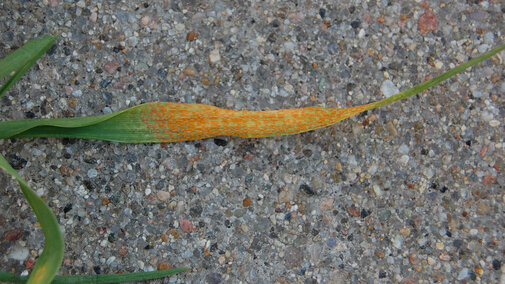Earlier this week, on Tuesday, November 1, wheat plants exhibiting signs of rust (yellowish-orange pustules running parallel with leaf veins) in the lower leaves were found in a field in Kimball County. This is the second successive year that rust has been found on fall-planted wheat in the Panhandle before the crop went into dormancy for the winter.
Wheat in Nebraska can be affected by three primary rust diseases—stem, leaf, and stripe rust. Over the last five to six years, stripe rust, caused by the fungal pathogen, Puccinia striiformis f.sp. tritici, has been the most widespread and predominant disease in Nebraska. It has severely affected crop yields and seed quality. In this particular field stripe rust was again identified as the culprit.
At this point we do not know how widely distributed the disease is throughout the region, nor how these fall infections will affect next year’s yields. More than 10 years ago we saw similar infections in the fall with leaf rust, but did not observe any yield reductions the following spring. Conversely, stripe rust was observed from several locations in October 2015, and disease was extremely damaging to wheat production during the 2016 growing season.
We are interested in learning of any additional reports of the disease this fall as we would like to monitor these fields for stripe rust emergence in 2017. In collaboration with the grower and Panhandle Coop we are planning to apply fungicide in this field this fall so we can compare disease development in it compared to untreated areas of the field, in an effort to evaluate the effectiveness of fall-applied fungicide treatments.
We also plan to begin stripe rust studies in 2017 to establish a predictive model for optimizing disease management decisions for growers. These studies will be conducted at several sites throughout the Panhandle and at collaborative sites in North Dakota using both a resistant and susceptible cultivar at each site. The idea is to estimate the risk of disease development influenced by a number of factors and make fungicide applications based on the newly developed model.
Reporting Rust in Wheat this Fall
If you suspect you're seeing rust in your wheat fields this fall, please contact Nebraska Extension Plant Pathologists Robert Harveson (rharveson2@unl.edu, 308-631-5953) or Stephen Wegulo (swegulo2@unl.edu, 402-472-8735), who are studying the efficacy of fall fungicide applications.

